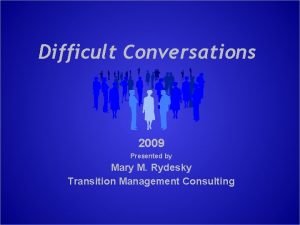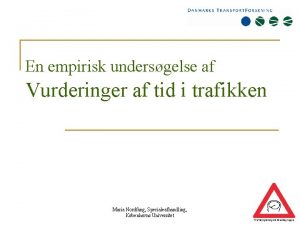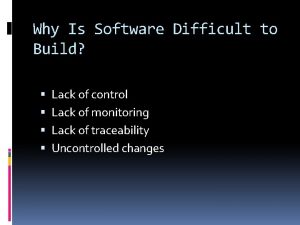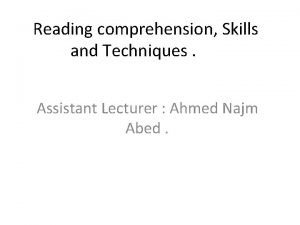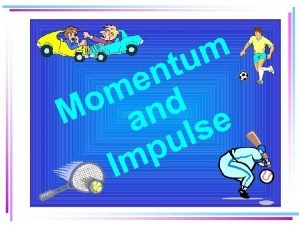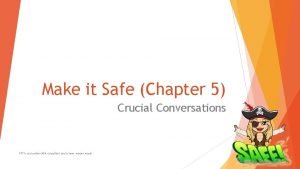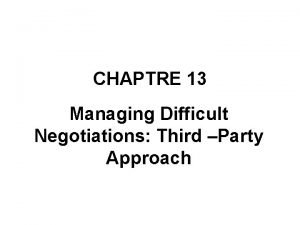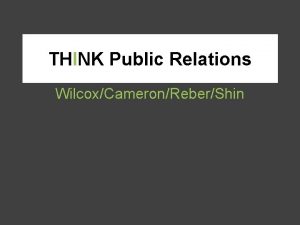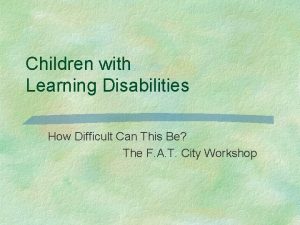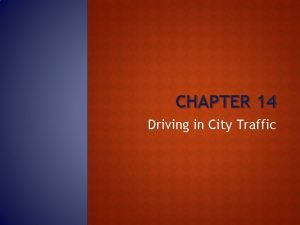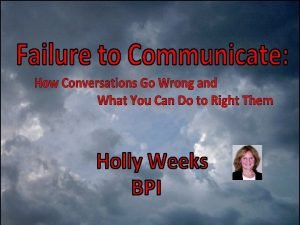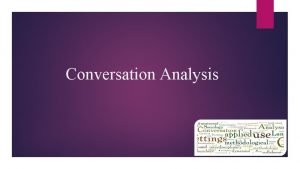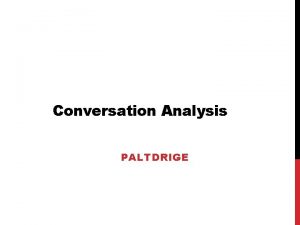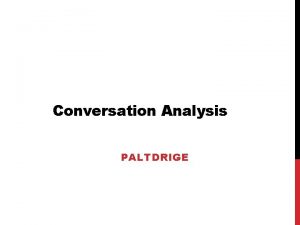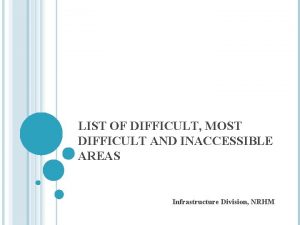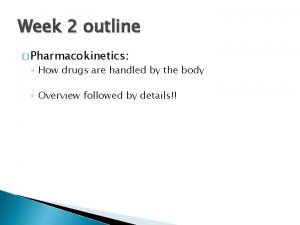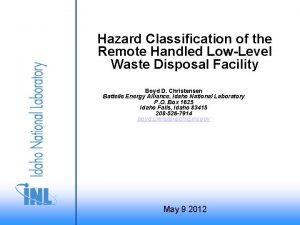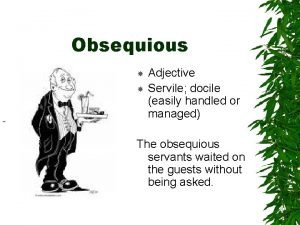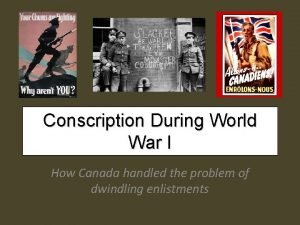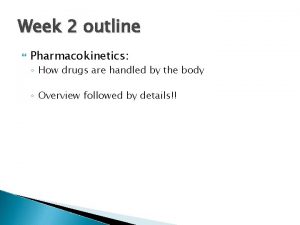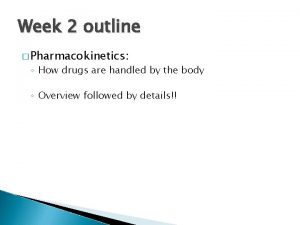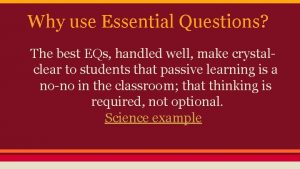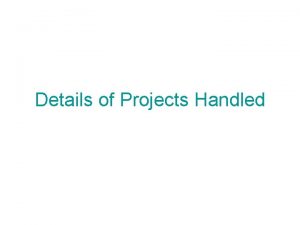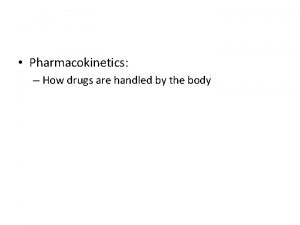How I handled a difficult conversation and survived


























- Slides: 26

How I handled a difficult conversation… and survived to tell the tale! IIBA BA-CON – August 2019 Insight Presentation

Hello! Melissa Keesing Teacher ∙ Coach ∙ Wife ∙ Mom ∙ Dog-Mom ∙ Theatre Nerd

Agenda for today • Crucial Conversation – What is it? • How do we respond and why? • How do we want to respond? • How do I move to action and results?

Photo Source Do your relationships at work or home always look like this?

Photo Source How often do they actually look like this?

Photo Source

Why do we have such a hard time handling difficult conversations?

The 7 Crucial Conversations Principles Start with Heart Learn to Look Master Your Stories Get the right focus. Know when it’s unsafe Make It Safe Stay in dialogue despite negative feelings Facilítate an open dialogue State Your Path Explore Others’ Path Move to Action Share your views persuasively Be a Good Listener Convert dialogue to results

How do people generally respond? SILENCE Withdrawing Avoiding Masking DIALOGUE VIOLENCE Controlling Labeling Attacking We either don’t handle the conversation or we don’t handle it well. Source: “Crucial Conversations – Tools for talking when stakes are high” from authors Kerry Patterson, Joseph Grenny, Ron Mc. Millan and Al Switzler

Why do people respond as they do? • Human Physiology is working against our best efforts!! • Complex interactions with no notice are hard • Our motive is what degrades first, not our behavior. Source: “Crucial Conversations – Tools for talking when stakes are high” from authors Kerry Patterson, Joseph Grenny, Ron Mc. Millan and Al Switzler

How do we want to respond? Recognize you’re in a crucial conversation. What do I do once I am in a crucial conversation? The crucial conversation happened; now what? Source: “Crucial Conversations – Tools for talking when stakes are high” from authors Kerry Patterson, Joseph Grenny, Ron Mc. Millan and Al Switzler

sin po Op s on crucial ti mo g. O pin g. E on Str ion s What is a Crucial Conversation? conversation High Stakes Source: “Crucial Conversations – Tools for talking when stakes are high” from authors Kerry Patterson, Joseph Grenny, Ron Mc. Millan and Al Switzler

When a discussion starts to become stressful, we often end up doing the exact opposite of what works. Dialogue You are not self-aware. You react poorly. You are self-aware after it occurs. You react poorly. You are self-aware in the moment. You avoid reacting poorly! • You can avoid reacting poorly by learning to look for: • When things become crucial • Safety problems in the conversation • When you move to silence or violence • Do you know your style under stress? Source: “Crucial Conversations – Tools for talking when stakes are high” from authors Kerry Patterson, Joseph Grenny, Ron Mc. Millan and Al Switzler

Activity/Discussion: What signs do I need to look for in myself that compromise safety in dialogue? + debrief

How do you act and feel in Crucial Conversations? 5 min

What if I missed signs that healthy dialogue is at risk? • Apologize when you have clearly violated respect • Clarify and remain aware of your intent • Commit to search for a goal that will benefit both of you…or find as much common ground as possible • Be genuine in your approach Source: “Crucial Conversations – Tools for talking when stakes are high” from authors Kerry Patterson, Joseph Grenny, Ron Mc. Millan and Al Switzler


How to stay in dialogue when you are angry, scared, or hurt • Retrace your path to determine how you arrived to the reasoning or conclusion you have • Beware of assumptions and jumping to conclusions • Understand facts from feelings Source: “Crucial Conversations – Tools for talking when stakes are high” from authors Kerry Patterson, Joseph Grenny, Ron Mc. Millan and Al Switzler

Activity: Facts vs. Feelings + debrief

1 Think of a difficult conversation: • That has happened that didn’t go very well, or • Needs to happen 2 Think of at least 1 -2 facts and 1 -2 feelings related to the scenario above. Document them on your worksheet. • • Team member has arrived late to our daily Scrum 3 times this week Our team agreements say we agree to be on time for meetings as a team • • Team members have approached me about this thinking you’ve stopped caring They are frustrated about what appears to be this person’s lack of respect for everyone’s time 5 min

During Crucial Conversations, do you say things in the wrong way? • Speak persuasively, not abrasively. • Learn a way to say risky things in a way that minimizes defensiveness -- STATE your path. Share your facts Tell your story Ask for other’s paths Talk tentatively Encourage testing “What” skills “How” skills Source: “Crucial Conversations – Tools for talking when stakes are high” from authors Kerry Patterson, Joseph Grenny, Ron Mc. Millan and Al Switzler

10 min Activity: Turn my “Facts vs. Feelings” in to dialogue + debrief

Share your facts Tell your story Ask for other’s paths Talk tentatively Encourage testing Source: “Crucial Conversations – Tools for talking when stakes are high” from authors Kerry Patterson, Joseph Grenny, Ron Mc. Millan and Al Switzler “What” skills “How” skills


How to turn Crucial Conversations in to action and results • Who will do • What by • When (and what) • Follow-up will be taken • Agree on WWWF • Hold one another accountable. • Incorporate crucial conversation skills in to your daily life. • Following up is important if you expect a change in behavior to be consistent. • As leaders, we owe it to ourselves and to our team mates to step up to moments of crucial conversations. Source: “Crucial Conversations – Tools for talking when stakes are high” from authors Kerry Patterson, Joseph Grenny, Ron Mc. Millan and Al Switzler

Thank you. Melissa Keesing Find me at Melissa. Keesing@insight. com Insight Presentation Thank you for coming!
 Work in pairs imagine you have survived an earthquake
Work in pairs imagine you have survived an earthquake Difficult conversations role play
Difficult conversations role play Difficult conversation preparation worksheet
Difficult conversation preparation worksheet Explain conditional macro expansion with example
Explain conditional macro expansion with example Håndled
Håndled Tabsaversion
Tabsaversion Congratulating and responding
Congratulating and responding Is ap seminar difficult
Is ap seminar difficult Why is software difficult to build
Why is software difficult to build Why is it more difficult
Why is it more difficult The way of a transgressor is hard
The way of a transgressor is hard You can easily forget how different life was 50 years ago
You can easily forget how different life was 50 years ago The james lange theory of emotion states that
The james lange theory of emotion states that Tell me all about this name that is difficult to say
Tell me all about this name that is difficult to say Paragraph reading
Paragraph reading Momentum is a measure of how difficult it is to
Momentum is a measure of how difficult it is to Crucial conversations chapter 5
Crucial conversations chapter 5 Managing difficult negotiations
Managing difficult negotiations The most difficult persuasive task is to
The most difficult persuasive task is to How difficult can this be
How difficult can this be Chapter 14 driving in city traffic
Chapter 14 driving in city traffic Lesson 2 our economic choices
Lesson 2 our economic choices Pre and post operative care for cesarean section ppt
Pre and post operative care for cesarean section ppt Thwarting ploys
Thwarting ploys Why was italian unification difficult to achieve
Why was italian unification difficult to achieve Rods airway
Rods airway Seas application category 4
Seas application category 4


